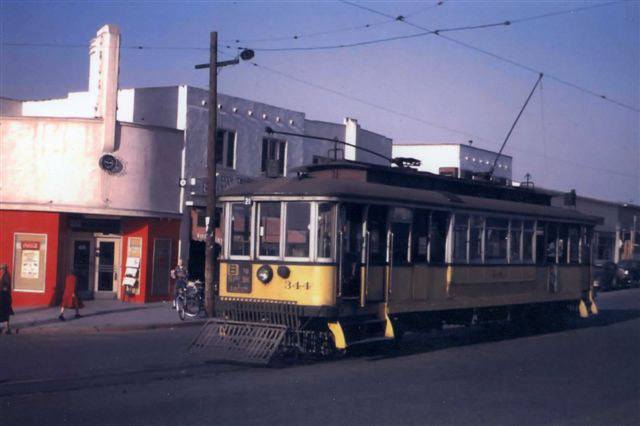344 at City Terrace
Los Angeles Transit Lines no. 344 rolls through City Terrace in this March 1948 photo.
Ken Douglas Photo
Ralph Cantos Collection
From Ralph Cantos:
A nice shot taken by Ken Douglas in March of 1948. LATL had not put the Trolley Coach wires yet. That started about June of 1948. The B line was abandoned on Dec 5, 1948. I use to sit at the curb at this location for hours on end, watching the motorman change ends.
Recent Posts
Showing 4 comments



Please excuse my ignorance, as I never saw a running PE car in its day, but when you say you used to watch the motorman change ends, what does that mean? Thanks for your reply.
“Changing Ends” was necessary at stub-end terminals. Nearly all PE lines were stub-ended, and until LA Railway started using PCC cars, they were the same way. The PE fleet was all double-ended, including the first double-ended PCCs. Such cars have duplicate controls and trolley poles at both ends. The motorman sets the brakes, raises the trolley pole at what had been the “front” takes the controller key (and sometimes the handle) and the brake handle to the other end of the car, takes down and hooks the other trolley pole, and places the “tools” in the controller and brake valve. On the PE “Blimps” the brake valve has to be “cut out” at one end and cut in on the other. There’s a safety latch that prevents removing the brake handle until the brakes are solidly applied. A similar procedure is used on Metrolink and other push-pull diesel powered commuter trains. Modern light-rail trains are somewhat simpler–the current collectors that replaced the trolley pole are bi-directional, and the operator just has to bring a key to unlock the control panel. Most railway museums with trolley cars can demonstrate “changing ends”, and the new “Red Car” ride at Disney’s California Adventure has double ended cars that were inspired by the PE, and, even though the trolley wire is not energized, the operators still change the trolley poles on their battery-powered streetcars.
Wow – thanks so much for the education and info, Mr. Davis! Very interesting!! Besides California Adventure, is there a railway museum with a similar trolley car in or around L.A. where you can see this being done? Isn’t there a railway museum in Riverside somewhere?
The museum near Riverside (actually 15 miles southeast in Perris) is Orange Empire Ry. Museum. We’re “oerm.org” on the Web–we just had our website overhauled. We have trains and trolley cars running on weekends, and the Museum is open weekdays, but does not normally operate. We have electric, steam and diesel locomotives, and trolley cars with two different gauges. The museum was established in Perris in 1958, and I have been a member since 1963.